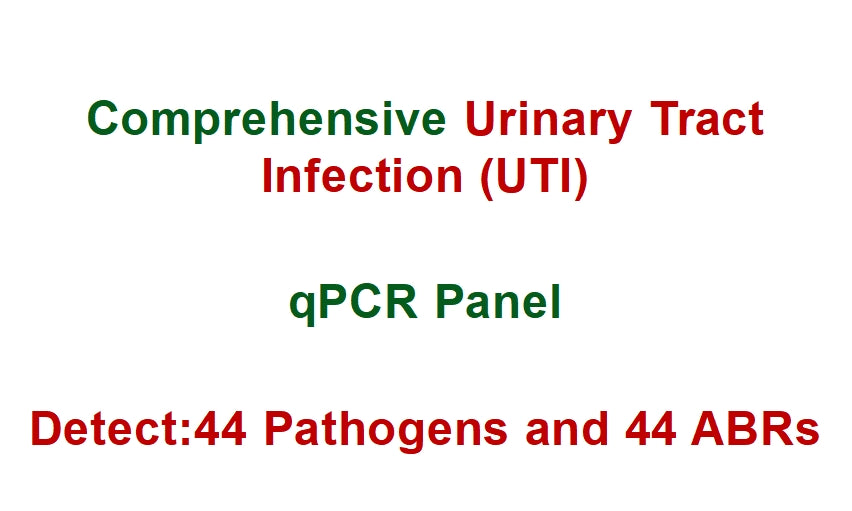Comprehensive Urinary Tract Infection (UTI) qPCR Panel
Comprehensive Urinary Tract Infection (UTI) qPCR Panel
Couldn't load pickup availability
Comprehensive Urinary Tract Infection (UTI) qPCR Panel
Urinary tract infections (UTIs) are some of the most frequently diagnosed infections, impacting any part of the urinary system—including the kidneys, ureters, bladder, and urethra. Most UTIs affect the lower urinary tract, specifically the bladder and urethra.
Who is at Risk?
- Women: Over 50% will experience at least one UTI in their lifetime; 20–30% of these women may face a recurrence within 6 months.
- Men: Less common in younger men, but rates rise significantly after age 50 due to prostate-related issues.
- Older Adults: UTIs are a leading cause of sepsis and hospitalization in elderly individuals, especially those in nursing homes.
- Children: Up to 8% of girls and 2% of boys will have had a UTI by age 7.
In the U.S., UTIs account for approximately 10 million physician visits and 1 million ER visits each year.
What Makes Our UTI Panel Different?
This qPCR-based panel is the most comprehensive on the market, capable of identifying:
- 44 pathogens: including bacteria, viruses, fungi, and protozoa
- 44 antibiotic resistance (ABR) genes
Molecular diagnostics deliver fast, accurate results—usually within 24 hours of sample receipt—providing a more reliable and efficient alternative to traditional urine cultures.
Why Choose Molecular UTI Testing?
✅ High Sensitivity & Specificity — Accurately detects pathogens often missed by culture methods
✅ Rapid Results — Results typically delivered within 24 hours
✅ Antibiotic Resistance Detection — Identifies resistance genes to support targeted therapy
✅ Ideal for Difficult Cases — Effective in identifying slow-growing or difficult-to-culture organisms
Molecular UTI testing is especially beneficial when conventional cultures are inconclusive, time-consuming, or fail to identify the causative agent.
Detected Pathogens
Viruses
Human Herpesvirus 5 (HHV-5 / Cytomegalovirus)
Herpes Simplex Virus 1 (HSV-1)
Herpes Simplex Virus 2 (HSV-2)
Bacteria
-
Escherichia coli
-
Klebsiella pneumoniae
-
Klebsiella oxytoca
-
Proteus vulgaris
-
Pseudomonas aeruginosa
-
Serratia marcescens
-
Citrobacter freundii
-
Citrobacter koseri
-
Enterobacter aerogenes (Klebsiella aerogenes)
-
Enterobacter cloacae
-
Morganella morganii
-
Providencia stuartii
-
Staphylococcus aureus
-
Staphylococcus epidermidis
-
Staphylococcus saprophyticus
-
Streptococcus agalactiae (Group B)
-
Streptococcus pyogenes (Group A)
-
Streptococcus gallolyticus subsp. pasteurianus
-
Viridans Group Streptococci (e.g., Streptococcus oralis)
-
Corynebacterium riegelii
-
Corynebacterium urealyticum
-
Actinotignum schaalii
-
Aerococcus urinae
-
Alloscardovia omnicolens
-
Gardnerella vaginalis
-
Mycobacterium tuberculosis
-
Chlamydia trachomatis
-
Neisseria gonorrhoeae
-
Mycoplasma genitalium
-
Mycoplasma hominis
-
Ureaplasma parvum
-
Ureaplasma urealyticum
-
Treponema pallidum
Fungi
-
Candida albicans
-
Candida auris
-
Candida glabrata
-
Candida parapsilosis
-
Candida tropicalis
-
Candida kruseii (Pichia kudriavzevii)
-
Candida lusitaniae (Clavispora lusitaniae)
Protozoa
-
Trichomonas vaginalis
44 Antibiotic Resistance Genes (ABRs)
blaACC: Acinetobacter-derived cephalosporinase
blaACT: AmpC-type cephalosporinase
blaCMY: Citrobacter freundii-derived AmpC-type beta-lactamase
blaLAT: Latent AmpC-type beta-lactamase
blaFOX: Cephamycin-hydrolyzing AmpC beta-lactamase
blaGES: Guiana extended-spectrum beta-lactamase
blaMIR: Morganella morganii-inducible cephalosporinase
blaVIM: Verona integron-encoded metallo-beta-lactamase
Cfr: Chloramphenicol-florfenicol resistance methyltransferase
CMY/MOX/DHA: AmpC-type beta-lactamases (CMY, MOX, DHA families)
CTX-M_1: Cefotaximase-Munich beta-lactamase group 1
CTX-M_2: Cefotaximase-Munich beta-lactamase group 2
CTX-M_8_25: Cefotaximase-Munich beta-lactamase groups 8 and 25
CTX-M_9: Cefotaximase-Munich beta-lactamase group 9
dfrA1: Trimethoprim-resistant dihydrofolate reductase type A1
dfrA5: Trimethoprim-resistant dihydrofolate reductase type A5
ermA: Erythromycin ribosome methylation A gene
ErmB: Erythromycin ribosome methylation B gene
ErmC: Erythromycin ribosome methylation C gene
IMP-1: Imipenemase metallo-beta-lactamase type 1
IMP-2: Imipenemase metallo-beta-lactamase type 2
KPC: Klebsiella pneumoniae carbapenemase
MCR-1: Mobile colistin resistance gene 1
MecA: Methicillin resistance gene A
MecC: Methicillin resistance gene C
mefA: Macrolide efflux gene A
NDM: New Delhi metallo-beta-lactamase
OXA-48: Oxacillinase-48 carbapenemase
OXA-51: Oxacillinase-51 carbapenemase (Acinetobacter)
PER-1: Pseudomonas extended resistance beta-lactamase
qnrA: Quinolone resistance protein A
QnrB_1of4: Quinolone resistance protein B (variant 1 of 4)
QnrB_2of4: Quinolone resistance protein B (variant 2 of 4)
QnrB_3of4: Quinolone resistance protein B (variant 3 of 4)
QnrB_4of4: Quinolone resistance protein B (variant 4 of 4)
qnrS: Quinolone resistance protein S
SHV: Sulfhydryl variable beta-lactamase
Sul1: Sulfonamide resistance gene 1
Sul2: Sulfonamide resistance gene 2
Tet(M): Tetracycline resistance protein M
Tet(S): Tetracycline resistance protein S
vanA2: Vancomycin resistance gene cluster A2
vanB: Vancomycin resistance gene cluster B
VEB: Vietnamese extended-spectrum beta-lactamase
Share
files/UTI.jpg
04:32 AM


